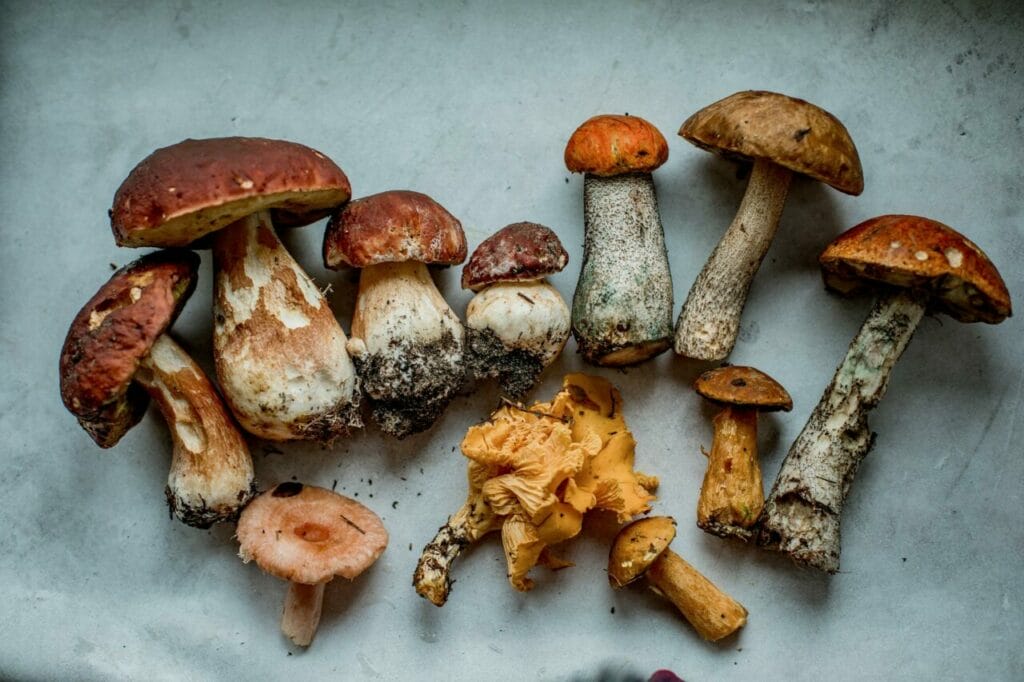Typically, anxiety treatment involves medication and therapy. However, their potential side effects may render them ineffective for some individuals. Such difficulties have sparked growing interest in alternative approaches like psychedelic therapy, employing substances such as “magic mushrooms Montreal” and others.
Discover your premium source for procuring psychedelics online in Canada. We provide prompt, secure, and confidential services.
[toc]Key Points:
- Psychedelic therapy combines the therapeutic effects of psychedelic substances with traditional talk therapy to expedite the healing process.
- Psychedelic therapy can boost emotional well-being and overall quality of life through spiritual exploration.
- The process of integration is a pivotal method in psychedelic therapy intended to ensure the enduring effectiveness of the therapeutic session.

Statistics on Anxiety Disorders in Canada
The 2022 Mental Health and Access to Care Survey data highlights an alarming increase in the prevalence of anxiety disorders in Canada. The proportion of Canadians aged 15 and above diagnosed with generalized anxiety disorder in the year preceding the survey has escalated from 2.6% in 2012 to 5.2% in 2022.
Contrasting Traditional Treatment and Psychedelic Therapy
Conventional treatments for anxiety disorders typically rely on a combination of psychotherapy and medication. Psychotherapy, also referred to as psychological counselling, is a collaborative process between a therapist and the patient to alleviate anxiety symptoms.
On the other hand, anxiety medications reduce symptoms by tailoring the treatment to the specific type of anxiety disorder, considering any concurrent mental or physical health conditions. Although treatments may differ based on individual situations, psychotherapy and medication form the core strategies.
In psychedelic therapy, the sessions are unique as they include one or two doses of a psychedelic substance, along with other therapeutic techniques:
Exploring Psychedelic Therapy
Psychedelic therapy is a form of therapeutic treatment that harnesses the potential benefits of psychedelic substances to enhance the healing process. These substances, renowned for their hallucinogenic properties, have been pivotal in holistic medicine and spiritual rituals across a variety of cultures for millennia.
The most frequently used substances in this type of therapy are Lysergic acid diethylamide (LSD) and psilocybin. LSD triggers alterations in mood, perception, and consciousness. As mentioned on the Health Canada website, psilocybin is the active ingredient in magic mushrooms. Consuming these mushrooms can intensify sensory experiences, such as visual, auditory, or tactile hallucinations.
Dosage Specification for Three Therapy Sessions
In psychedelic therapy, experts assess patients to determine the appropriate psilocybin dosage for their sessions. Dosages can vary, with some patients beginning at moderate levels, while others may be able to handle larger amounts of the substance. The usual treatment plan includes one to three drug sessions, each lasting six to eight hours and spaced several weeks apart. This method deviates from the traditional practice of taking medications daily until a healthcare professional instructs otherwise.
Experiencing Spiritual and Transformational Insights
Unlike anxiety medications that simply manage symptoms, therapeutic interventions aim to tackle the root causes of the disorder. Psychedelic therapy can significantly impact emotional health and overall quality of life.
The immersive experiences often lead to profound realizations, increased self-awareness, and enhanced emotional processing. These effects can stimulate personal development, inspire positive behavioural modifications, and improve overall mental health.
Impact
| Expanded Consciousness | Altered states of consciousness provide a new outlook on the world. | Such heightened awareness often results in: Deep realizationsEpiphaniesEnhanced comprehension of oneself and one’s surroundings |
| Emotional Healing | Facilitates emotional healing by offering an opportunity to face and work through unprocessed trauma, grief, or emotional pain. | This process assists in:Reaching deeply embedded emotionsReleasing emotional hindrancesPromoting emotional well-being |
| Increased Self-Awareness | Enhances connectivity among sensory brain regions while reducing connectivity within the default mode network. This network integrates brain regions that are interconnected, focusing on self-referential thinking and one’s subjective self-perception.” | These regions aim to: Transform negative thought patterns, beliefs, and habitual behaviours. Empower users to gain profound insights into their authentic selves, motivations, and interpersonal interactions. |
Somatic Therapy
Somatic therapy, although not commonly linked with psychedelic therapy, is garnering interest due to its potential benefits. This body-oriented method explores the connection between the mind and body. It is based on the principle that past traumas can result in sensations being trapped in the body. Somatic therapists help individuals identify these bodily sensations and use therapeutic techniques to alleviate this tension.
Integration
This offers a framework for clients to attain clarity, acquire perspective, and cultivate wisdom from their psychedelic experiences. The transformative process occurs during integration sessions with the therapist and through the client’s proactive initiatives outside of psychedelic journeys. Integration enhances the transformative effects of psychedelics by actively engaging with surfaced insights and emotional revelations.
Types of Integration
- Journaling. By documenting experiences, individuals can consolidate memories for easier future recollection. It also enables clients to examine their experiences from various perspectives to uncover alternative interpretations, implications, and connections.
- Art. This provides a potent way to encapsulate the complex emotions and feelings from a psychedelic journey in a creative and visually expressive way.
- Practicing Nature-based Approaches. These can be as simple as taking mindful walks in the forest or finding peace next to a calm body of water. Therapists can guide clients in recognizing the intricate patterns within nature or suggest utilizing natural elements like plants, stones, water, and candles as grounding tools.
- Engaging in Integration Groups. Group sessions with individuals who have had similar experiences offer a valuable opportunity for reflection, support, and connection. The ability of psychedelic therapy to foster a sense of interdependence and mutual understanding beyond individual boundaries is fundamental.
The Significance of These Techniques in Treating Anxiety
The basic pharmacological principle behind all psychedelics is their ability to act as agonists, or activators, of serotonin (5-HT) 2A
Psychedelics like psilocybin work by interacting with the serotonin receptor. Much of the research on psychedelics is centred on their influence on the brain’s default mode network. This network is significantly linked to repetitive thoughts and has been connected to conditions such as depression and anxiety disorders. Treatment can significantly reduce anxiety levels, with the effects lasting up to 12 months after treatment.
After a session involving psilocybin, which often includes profound spiritual experiences, the patient participates in a conversation with their therapist. In these talk-therapy sessions, trained healthcare providers strive to listen carefully to the patient. They also incorporate specific practices and techniques to enhance the positive outcomes of the treatment.
All these techniques work together to help those with anxiety achieve lasting relief in fewer sessions than traditional treatments.
Create a New Personal Reality, One Session at a Time
Many people rely on traditional treatments for anxiety, but they don’t work for everyone. Psychedelic therapy offers a different approach, using distinct methods that can trigger transformative experiences. These techniques work together to deliver deep, long-lasting results—sometimes lasting up to a year after just one to three sessions.
Beyond improving mental health, this therapy could also result in significant cost savings for patients. Ready to explore a new path to wellness? Discover the power of psychedelic therapy with Where To Buy Shrooms Canada.
Frequently Asked Questions
Is a particular type of magic mushroom used for psychedelic therapy?
In studies of psychedelic-assisted therapy, it’s often overlooked to specify the type of mushroom used. Psilocybe cubensis is typically the mushroom of choice.
Online magic mushroom dispensaries offer a variety of strains to suit different preferences. You have the freedom to choose any strain to experience the therapeutic benefits of psychedelics. However, it’s crucial to be mindful and choose a reputable vendor to avoid acquiring unsafe magic mushrooms from dubious sources.
What is the duration of psychedelic therapy?
The length of psychedelic therapy can vary as it consists of several stages. A single session in which the psychedelic is consumed can last from 4 to 8 hours. The entire process of the therapy, including preparation, the session itself, and subsequent discussions, can span a few weeks to several months.
In terms of lasting effects, individuals often report improvements in their mental health lasting for several months or even up to a year after therapy.
Some improvement can be seen after only a single session, with multiple sessions also available.
Does the therapist guide the patient on their spiritual journey?
During the spiritual journey, the patient may be guided by professionals such as therapists or other staff members. Research has shown that Spiritual Health Practitioners (SHPs) offer specialized and invaluable support, enhancing overall well-being and aiding progress throughout the journey. Some individuals may choose to seek guidance from an SHP, while others may rely on the available therapist or specialist.
Are “set and setting” integral to the psychedelic therapy process?
Indeed, the individual’s mindset (set) and the surrounding environment (setting) play a critical role in safely facilitating spiritual experiences during psychedelic therapy. The person’s mental state, which can influence the experience both before and during the psychedelic session, shapes their spiritual journey. Factors such as beliefs, expectations, emotional states, and intentions determine the direction and depth of the experience.
Primary Source: Psychedelics as Emerging Treatments for Anxiety Disorders: Opportunities and Challenges in a Budding Field – PMC (nih.gov)
About the Authors:
Franklin King, IV, MD. and Rebecca Hammond, M.D.
Related Articles:





